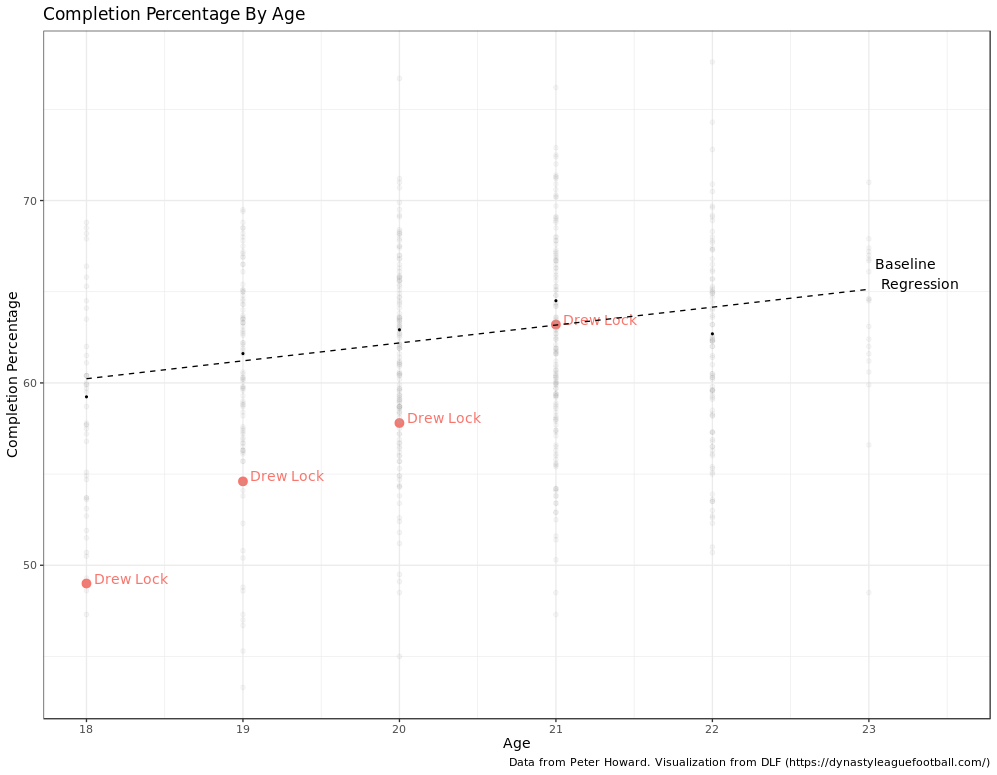Breakout or Fakeout: Drew Lock
In the ‘Breakout or Fakeout‘ series, we identify unproven players whose values are more reliant upon their potential than their production. Will they step up and become must-start fantasy assets? Or are they players to avoid? Read on to find out…
Drew Lock was once an exciting gunslinger at the University of Missouri, leading the FBS with 44 touchdown passes as a junior in 2017. Even with such gaudy production, Lock received a poor grade from NFL evaluators and elected to return for his senior season. His calling card was “NFL size with a big arm”, but looking under the hood revealed some major flaws.
Changing his image
Lock found success under Missouri offensive coordinator Josh Heupel, whose deep passing attack showcased his cannon and placed less emphasis on timing and accuracy. Following 2017, Heupel took a promotion to be the head coach at Central Florida. Derek Dooley filled the vacancy and installed a “pro-style” offense which incorporated more intermediate throws and complex routes.
In 2018 the Tiger offense sputtered relative to their previous highs, and Lock’s raw numbers weren’t as exciting. However, he did improve in one area: completion percentage (comp%). The biggest knock on him was the sub-60% rate he displayed as an underclassman but as a senior he registered about 63%. While a career high for Lock, using the DLF college market share app we can see this is still just about average for a senior quarterback since 2000.

Additionally, Lock’s yards per attempt (YPA) fell from 9.5 to 8.0, which is below the median I like for a prospect. I have previously found that quarterbacks who finish as top-five fantasy performers in the NFL meet a threshold of 8.2 YPA in college. Lock’s senior season brought him down to a career 7.9 YPA.
He successfully brought his comp% up to a respectable level at the expense of YPA. This is a concerning development for his future.
Transition to the NFL
After his senior season, Denver selected Lock in the second round of the NFL Draft. Rumors swirled that Broncos general manager John Elway was infatuated with Lock’s physical attributes. However, even after the selection it was noted he needed time to develop.
Despite the party line, a front office usually wants to see what they have in quarterbacks who were chosen early. After 12 weeks of Joe Flacco and Brandon Allen, the QB of the future was unleashed. Lock went 4-1 as a starter, however his production was quite underwhelming.
Most concerning for his dynasty prospects was the continued trend of sacrificing YPA for accuracy. In his five starts, Lock had his highest comp% since high school at 64%. This would usually be a promising development, and puts him as the ninth most accurate rookie QB with five or more starts since 2000. However, his YPA was unimpressive at 6.5, ranking below undrafted dumpster fire Devlin Hodges.
According to Josh Hermsmeyer’s airyards.com, Lock continued to be a bad passer on intermediate routes. His completion percentage started dropping at a depth of target over 10 yards and was substantially below the NFL average between 15 and 35 yards.

His solid completion percentage disguises an extremely unchallenging approach for defenses. Completion percentage and average depth of target (aDOT) can be blended into a stat called completion percentage over expected (CPOE). This is a helpful number to evaluate a quarterback’s true talent against another. Lock’s CPOE for 2019 was -2.3% meaning given the depth of his targets, he completed fewer passes than the average NFL QB. What’s worse is that his aDOT was sad to begin with at 6.8 yards, ranking 33rd of 38 QBs with at least 150 attempts.
Going down with the ship
For fantasy purposes, he is not only an uninteresting QB option but also brings down all Broncos pass catchers. Courtland Sutton enjoyed a breakout in 2019 with a 72-1,112-6 line, finishing as the WR17 in PPR formats. In weeks 1-12, Sutton saw 7.7 targets per game and turned those into an average line of 4.5-76-0.5.
After Lock took over, Sutton saw a volume increase to 8.8 targets per game but Lock’s targets proved to be less valuable. Sutton’s average line in weeks 13-16 was 4.5-52-0. His yards per target was almost cut in half. Noah Fant saw his targets drop from 4.7 per game to 2.8. Some good news is that his efficiency increased, gaining 11 yards per target with Lock compared to 8 without.
The offense as a whole was less effective with Lock under center, gaining 302 yards per game weeks 1-12 versus 289 weeks 13-17. After removing the 134 total yard rock-bottom debacle week 12 in Buffalo, the average difference is more striking, 318 vs. 289 yards.
Nowhere to go but up?
I’d be happy to let Lock’s rookie season slide, except that he has been trending this way since 2017. When asked to tighten up and play precise football he seems to shrink from the exciting player we saw as a junior at Missouri.
He may develop like Elway desires, but to this point he has not shown the ability to overcome the problems identified in college. Almost all NFL prospects have a strong arm, but few can channel that power into pinpoint windows with timing and touch.
In an attempt to complete more passes, Drew Lock is morphing into late-phase Derek Carr. He will have a long leash and see plenty of snaps, but at this point I am bearish on his chances of being a difference-maker for your fantasy teams.
Verdict: Fakeout
- Senior Bowl: Stock Up and Stock Down - February 1, 2021
- Bowl Game Previews: December 31 - December 31, 2020
- Bowl Game Previews: December 30 - December 30, 2020

































































